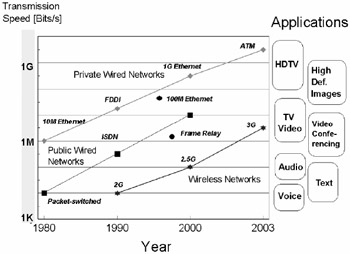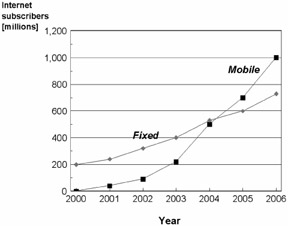1.1 Introduction
1.1 Introduction
The wireless Internet is coming of age! Millions of people worldwide already are using Web phones and wireless handheld devices to access the Internet. Nations and corporations are making enormous efforts to establish a wireless infrastructure, including declaring new wireless spectrum, building new towers, inventing new handset devices and high-speed chips, and developing protocols.
The adoption of the wireless Internet strictly depends on the mobile bandwidth, the bandwidth of access technologies. The current 2G wireless access technologies transmit at 9.6 to 19.2 kbps. These speeds are much slower than the dial-up rates of desktop PCs connecting to the Internet. However, 2.5G wireless technologies already in use provide speeds of 100 kbps, and 3G technologies with speeds of 2 to 4 Mbps will allow wireless connections to run much faster than today's wired cable and DSL services. Figure 1.1 illustrates the transmission speeds of wired networks and their applications. This figure includes wireless access networks, showing that 2G networks are basically used for voice and text messaging, but 2.5G networks and particularly 3G networks will open doors for many new wireless applications that use streaming video and multimedia.

Figure 1.1: Wired and wireless networks and their applications.
Today, the number of subscribers with fixed Internet access is much higher than those with mobile Internet access. However, according to a forecast from Ericsson, in several years the number of mobile subscribers to the Internet will reach 1 billion and will be higher than those having fixed access (see Figure 1.2).

Figure 1.2: Mobile Internet access. (Source— Ericsson, Basic concepts of WCDMA radio access network, White Paper, www.ericsson.com, 2002.)
In this chapter, we introduce the fundamental concepts of wireless Internet. In Section 1.2, we describe the basic principles of wireless communications, including wireless network technologies. Section 1.3 presents the modulation techniques and basic access technologies. Wireless Internet networks are described in Section 1.4, while wireless devices and their functionality are presented in Section 1.5. Section 1.6 gives an overview of current and potential wireless Internet applications, while some future trends in wireless technologies are discussed in Section 1.7. Concluding remarks are given in Section 1.8.
EAN: 2147483647
Pages: 239